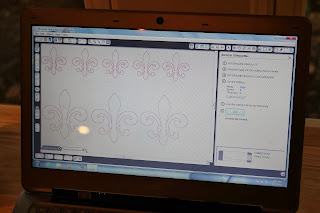Stencils are what allow Miss Ginger to be an artist.... trust, honey, this bitch can't draw a straight line, much less a shape that looks like anything other than a blob! Those of you as "advanced in age" as Miss G may remember the manila stencils we used to buy at the dime store whenever we had to make posters for school. You held them against the poster board, and traced within them with a pencil or crayon, and it made all of your lettering look like it was cargo from overseas!
While you can now find plastic stencils at many craft stores, you are limited to the designs that are available, and these stencils still have the basic problem that has plagued reusable stencils since the beginning of time: "floating" negative space has to be connected with a void, causing that "stencilly" look that says "8th grade poster from the 70's!"
Every modern craft room today has some sort of "die cutter" to make hearts and flowers out of all sorts of sheet goods making scrapbooks pop and cards extra-special. If you don't have one, flip over to amazon.com and order one right now! I'll wait....
Seriously, if you don't have one, follow this link to Miss Ginger's Consumer Product Review. You need one, so you might as well know what you are shopping for! Once you get it, you will want to know how to use it to make stencils.

Using the software included with the machine, Miss Ginger selects the design she wants to stencil, and downloads it over the internet. Once she has the file, she can resize it, flip it, rotate it, duplicate it, stretch it, etc.... until she has exactly what she wants.
 With the design manipulated to her liking, Miss G loads the vinyl into the machine and cuts the stencil.
With the design manipulated to her liking, Miss G loads the vinyl into the machine and cuts the stencil.
Once the stencil is cut, she removes the part of the design she doesn't want; a process we call "weeding." By weeding away the actual design, she leaves a stencil to create a "positive" image on her material. She could, conversely, weed away the surrounding material, leaving the shape as a "mask" to create a "negative" image on her final work. If you're confused (I am!) it will make more sense in a minute!
Once the stencil is weeded, Miss Ginger applies transfer paper on top of the stencil. Sometimes called "flypaper," the transfer paper comes in a roll like a huge roll of masking tape, and it is designed to stick best to the vinyl material without damaging it. It also sticks veraciously to itself, so be careful! Once the flypaper is in place, use a brayer or the edge of a credit card to smooth out wrinkles and activate the adhesive.
Now you can flip the stencil over and peel the backing paper away from the vinyl, because the transfer paper will keep all of the vinyl in place. With the adhesive exposed, the stencil can be applied to the object you are decorating. What can one stencil with this technique?
I'm so glad you asked!
Here, Miss Ginger stenciled the fleur-de-lis onto a glass bottle to create her wind chime. With the stencil in place, she used a rotary tool with a diamond bit to abrade the design. Because the stencil is completely waterproof, you can also use it with etching cream to create more delicate designs on glass.
 You can use glass paint to create a stained-glass effect....
You can use glass paint to create a stained-glass effect....
....or stencil with paint onto wood, metal, or other materials to create signs or other decor. You can even stencil directly onto walls, mirrors, and windows to give your home a custom look!
Once your image is complete, just peel away then stencil and your done! Here are a couple of hints from Miss Ginger to help you along:
1. Test the adhesive on an inconspicuous piece of your material before applying your stencil. The adhesive on the vinyl may be too aggressive for some painted surfaces, and my remove the paint when you pull it away. If your surface fails the adhesive test, try cutting your stencil out of stiff paper, and spray it with repositionable adhesive on the back. This extra step should allow you to apply and remove the stencil without damaging the surface.
2. When stenciling with paint, remove the stencil while the paint is still wet. This will prevent the stencil from lifting the paint film, creating a jagged edge.
3. On glass, you may need to use a razor blade to scrape the vinyl away from detailed images. The vinyl sticks pretty aggressively to glass. If this won't work with your application, use paper and spray adhesive.
Have fun, and please leave a comment with links to your most creative endeavors!













